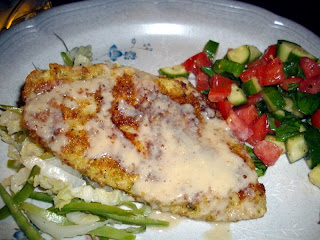 I'm not sure what it is about the fish tales that makes them so much more apt to wriggle through my narrative net. Looking at my blog backlog, I see that we're pretty much caught up, with only two recent fish feasts having gone without comment. So let's reel in those bad boys.
I'm not sure what it is about the fish tales that makes them so much more apt to wriggle through my narrative net. Looking at my blog backlog, I see that we're pretty much caught up, with only two recent fish feasts having gone without comment. So let's reel in those bad boys.Salmon is not one of Master's favorites. And I concede that it can be a good deal fishier than many of the mild, white fish I've favored for our Friday dinners. The upshot is that salmon requires some sweetening of the deal. In this case, I took the idiom to heart, baking the fish to a flaky finish in a sweet and tart marinade of clementine juice, brown sugar, balsamic vinegar and minced garlic.
The borlotti beans were acquired during the early legs of a long Wednesday afternoon walk. I had stopped in for a mango granita and found myself unable to resist those attractively marbled magenta, green and white pods. I ended up walking around Downtown for hours, clutching the plastic bag that held my precious freight until numb fingers forced me to relinquish it. The Swiss chard was more of a last minute purchase, though no less irresistible in its leafy abundance. Master was kind enough to shell the beans while I chopped up a fennel bulb, onions, and Roma tomatoes, and waited for the water to come up. The beans boiled, the fennel simmered in stock with a handful of thyme. I was up to my elbows in chard, cutting stems from leaves, which amassed to bury the cutting board, the kitchen counter - even the knife often enough for the task to feel akin to blazing through dense underbrush with a machete. The chard, reduced to manageable bites, sauteed until just crunchy and still rubicund. I squeezed in some lemon juice before serving.
I thought everything tasted great. Master ate, and seemed to enjoy the meal, though I could tell that neither the salmon nor the sides were ever going to be favorites. He explained it as the difference between "mmmm" and "yummy!" He's a tough one to please. But I am not so easily deterred.
 And sometimes I do hit that "yummy!" bullseye, as I managed with this dinner of baked flounder, tomatoes Provençal, and gingered carrots. Though you may just see a hodgepodge of herb-y, crumb-y sameness above, I assure you that the tomatoes and the fish were total textural contrasts. Beneath their thin, crackly crust, the breadcrumbs baked into the tomatoes (which had just been plucked from their garden vines) were soft, peppery, and dense from absorbed juices, Parmesan cheese, parsley, and olive oil. The breading on the flounder was crisp and light, flavored with citrus zest and thyme. The carrots were just barely glazed in a sugar-and-ginger syrup, in the manner I've found Master likes best. Every element of the plate was calculated to please and, though I may have gone a bit overboard with the black pepper, it was a huge hit. We only wished I'd made more of the tomatoes. I really thought that a dozen - all that the casserole dish would accommodate - would be enough for two people. Ah, but I should have realized that standard serving math does not apply where good tomatoes Provençal is concerned, and that the only guarantee is that enough is never enough.
And sometimes I do hit that "yummy!" bullseye, as I managed with this dinner of baked flounder, tomatoes Provençal, and gingered carrots. Though you may just see a hodgepodge of herb-y, crumb-y sameness above, I assure you that the tomatoes and the fish were total textural contrasts. Beneath their thin, crackly crust, the breadcrumbs baked into the tomatoes (which had just been plucked from their garden vines) were soft, peppery, and dense from absorbed juices, Parmesan cheese, parsley, and olive oil. The breading on the flounder was crisp and light, flavored with citrus zest and thyme. The carrots were just barely glazed in a sugar-and-ginger syrup, in the manner I've found Master likes best. Every element of the plate was calculated to please and, though I may have gone a bit overboard with the black pepper, it was a huge hit. We only wished I'd made more of the tomatoes. I really thought that a dozen - all that the casserole dish would accommodate - would be enough for two people. Ah, but I should have realized that standard serving math does not apply where good tomatoes Provençal is concerned, and that the only guarantee is that enough is never enough.

































